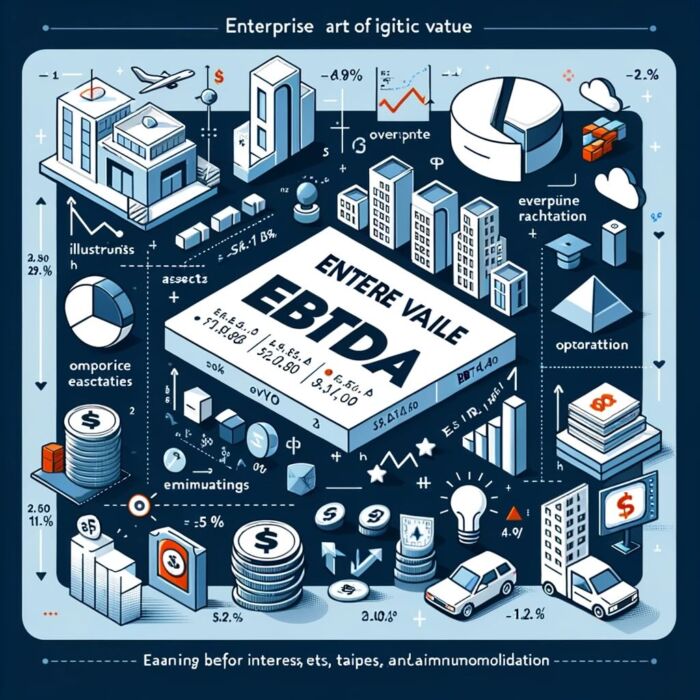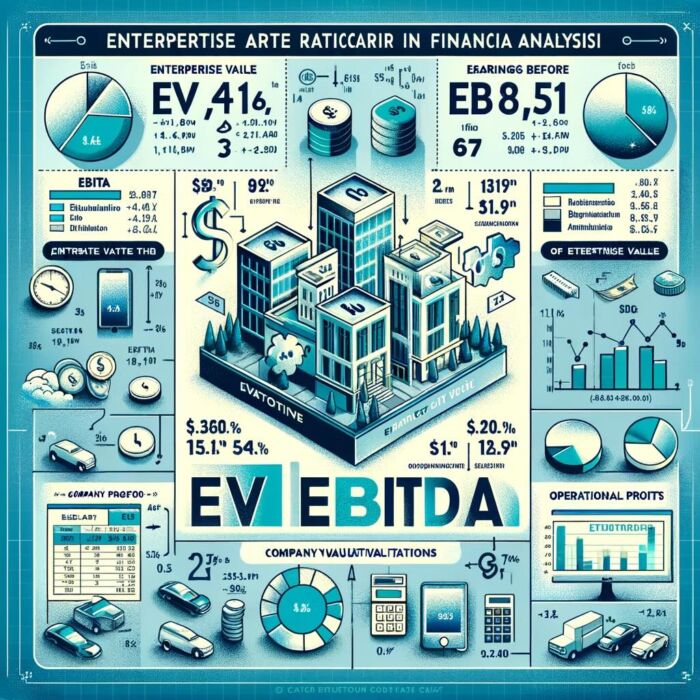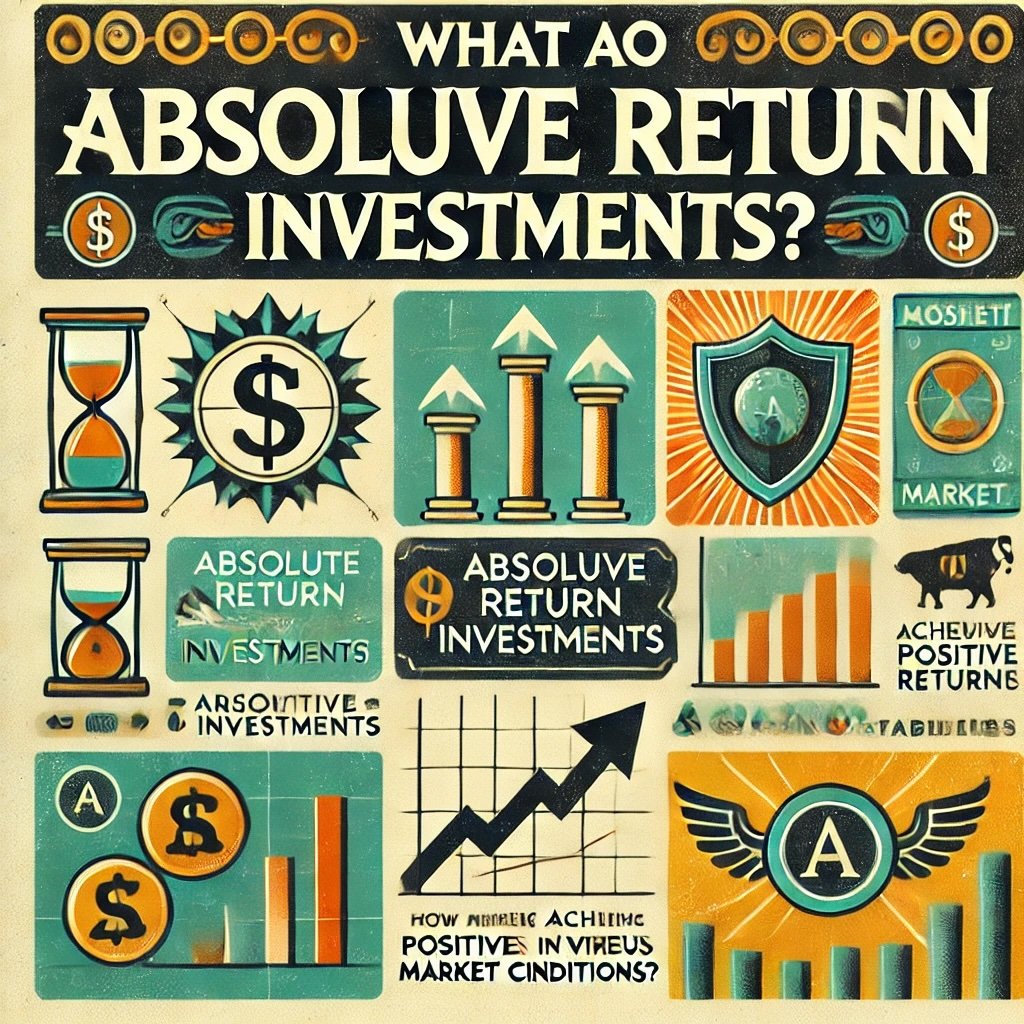Welcome, financial enthusiasts and investment aficionados, to this deep dive into the lesser-known corners of value investing. If you’ve come seeking a fresh perspective beyond the familiar land of price-to-earnings ratios, or you’ve heard whispers of this enigmatic acronym, EV/EBITDA, and want to unravel its mysteries, then you’re in the right place. Strap in, as we’re about to embark on a journey to uncover a powerful, yet understated tool in the arsenal of savvy value investors – the EV/EBITDA ratio.

First things first, let’s unravel the acronym. EV/EBITDA stands for Enterprise Value to Earnings Before Interest, Taxes, Depreciation, and Amortization. I can already sense your intrigue building. Yes, it’s a mouthful, but don’t let this lengthy moniker intimidate you. In the realm of investing, it’s an incredibly powerful tool, capable of illuminating undervalued stocks like a flare lighting up the darkest night.
The EV/EBITDA ratio is a key player in the world of value investing. At its core, value investing is all about finding and investing in companies that are undervalued by the market, like unearthing hidden gems buried beneath heaps of overlooked stocks. And this is where the EV/EBITDA ratio truly shines. It offers a new perspective, a different lens through which to assess a company’s worth, often revealing valuable opportunities where others might not see them.

Importance of EV/EBIDA Ratio
In this article, we will journey together through the complex, fascinating landscape of EV/EBITDA. We will break down its components, explore its role and advantages in value investing, and understand how it stacks up against other financial metrics. We’ll also delve into its limitations, because like any tool, it’s not a magic wand that can grant investing success with a single wave. Finally, we’ll show you how this secret weapon is employed by seasoned value investors, providing you with real-world applications and strategies that you can incorporate into your own investment journey.
So, ready your financial compass, and let’s set off on this thrilling journey to unmask the secret weapon of value investing – the EV/EBITDA ratio. Prepare to have your investing worldview broadened and enriched, because we are about to venture into territory that few casual investors ever explore.

Understanding the EV/EBITDA Ratio

Definition of Enterprise Value (EV)

Let’s embark on the first leg of our journey by cracking the code of EV, or Enterprise Value. Picture Enterprise Value as a gigantic shopping tag placed on a business. This isn’t just any tag that tells you the cost of a pair of shoes or a fancy gadget. No, this tag is comprehensive. It tells you how much it would cost to purchase the entire business – lock, stock, and barrel.
EV accounts for the market capitalization of a company (the cost of all its shares), plus its total debt (including bonds, loans, etc.), minus its cash and cash equivalents. Why subtract cash, you might ask? Well, think about it this way: if you bought a house that had a stash of cash in a safe, you’d count that as a discount on the purchase price, right? That’s essentially what the cash component in EV does. It takes into account that a new owner could use the company’s own cash to finance part of the acquisition.
Definition of Earnings Before Interest, Taxes, Depreciation, and Amortization (EBITDA)
Now, onto the second part of our ratio: EBITDA. EBITDA is like the financial stethoscope that allows you to listen to the heartbeat of a business. It tells you how much profit the business made from its core operations, ignoring things like tax environments, interest payments on debt, and the gradual wear and tear of assets.
EBITDA stands for Earnings Before Interest, Taxes, Depreciation, and Amortization. It provides an overview of a company’s operational performance without getting tangled in the web of financing decisions, tax jurisdictions, or the varying depreciation policies, thus giving an investor a more straightforward look at the company’s profitability from its core business operations.
Calculation of the EV/EBITDA Ratio
So, we’ve broken down EV and EBITDA. Now, let’s put the pieces back together and calculate the EV/EBITDA ratio. Drum roll, please!
Well, as you might’ve guessed, calculating this ratio is as simple as dividing a company’s Enterprise Value (EV) by its Earnings Before Interest, Taxes, Depreciation, and Amortization (EBITDA). This ratio represents the payback period for the hypothetical complete pay-off of the company if its EBITDA remains constant, and if it doesn’t distribute its profits as dividends.
Interpretation of the EV/EBITDA Ratio
The EV/EBITDA ratio is a financial lens, letting us see through the fog of market prices to the more stable ground of a company’s real earning capacity. But how do we interpret what we see through this lens?
A lower EV/EBITDA ratio could suggest that a company is undervalued, making it a potential steal for eagle-eyed investors. On the other hand, a high ratio might indicate that a company is overvalued. However, there’s a bit of a caveat: these interpretations are often relative to industry averages or the company’s historical averages. Certain sectors might have a naturally higher EV/EBITDA ratio due to the nature of their business.
Thus, the EV/EBITDA ratio isn’t just a number – it’s a story. It’s a tale of what a company is truly worth, beyond the fleeting whims of market prices, waiting to be interpreted by an informed and discerning investor. And that, dear reader, could be you! Stay with us as we continue to demystify this fascinating tool.

Importance of the EV/EBITDA Ratio in Value Investing
Comparison with P/E Ratio
In the world of value investing, P/E or Price-to-Earnings ratio has long been the celebrated star of the show. It’s the charming, popular kid that everyone wants to hang out with. But let me introduce you to the understated genius, the EV/EBITDA ratio. While P/E ratio offers a quick glance at a company’s value by comparing its market price per share to its earnings per share, EV/EBITDA delves deeper, providing a more holistic, in-depth view of a company’s value.
The P/E ratio is akin to judging a book by its cover, potentially clouded by the market’s emotional swings. In contrast, the EV/EBITDA ratio is like reading through the pages, understanding the plot, and appreciating the storyline, revealing the value that’s often missed in a superficial glance.
Ability to Determine a Company’s Real Value
EV/EBITDA cuts through the noise of market sentiment and dives straight into the heart of a company’s operations. Its ability to reflect a company’s true value is comparable to a gold prospector’s pan, sifting through dirt and gravel to reveal the shiny nuggets beneath. It factors in debt, cash, and a company’s core earnings potential, unmasking the company’s real worth under all the layers of financial complexity.
Identifying Undervalued Companies
Every value investor dreams of discovering the next hidden gem, and the EV/EBITDA ratio often serves as their treasure map. A company with a low EV/EBITDA ratio might be undervalued, overlooked, or underestimated, waiting for the discerning investor to recognize its untapped potential. It’s like finding a priceless antique at a yard sale – the seller doesn’t realize its worth, but the knowledgeable collector knows its true value.
Assessing Companies with Different Capital Structures
In a world full of diverse companies with different capital structures, EV/EBITDA is the financial polyglot that speaks all their languages. It levels the playing field, allowing for a more apples-to-apples comparison between companies, regardless of their debt or equity financing, their geographic location, or their tax situations. It’s like a universal translator, allowing you to assess a debt-laden telecom company in the same terms as a high-growth tech start-up.

Advantage over Other Valuation Tools
The EV/EBITDA ratio is a financial Swiss army knife, offering versatility and utility that many other valuation tools lack. It reaches where P/E ratios can’t, offering insights that book value ignores, and providing a perspective that dividend discount models might overlook.
Consider it the all-terrain vehicle of financial metrics, capable of traversing the rugged landscape of high-debt companies, the rocky terrain of firms with substantial non-cash expenses, and the slippery slopes of businesses with substantial cash reserves. In the hands of a savvy investor, the EV/EBITDA ratio can be a powerful tool to navigate the diverse topography of the investing world.
source: StockEdge on YouTube

The Role of the EV/EBITDA Ratio in Various Industries
Variation of the EV/EBITDA Ratio across Different Industries
As we journey further into the realm of EV/EBITDA, it’s time to take a more panoramic view and observe its variations across different industries. Just as a seasoned chef understands that different cuisines require unique spices, a discerning investor knows that each industry has its own financial flavor profile, including its average EV/EBITDA ratio.
In the bustling tech industry, EV/EBITDA ratios may soar sky-high, mirroring the ambitious growth expectations and aggressive pricing of this sector. In contrast, more traditional industries like manufacturing or utilities might exhibit lower ratios, reflecting their stable, albeit less flashy, earnings potential.
Explanation of Industry-specific Differences
Why such variation, you might ask? Well, it all comes down to the characteristics of each industry. In sectors where rapid expansion and future growth prospects are the talk of the town, companies are often willing to take on higher levels of debt, leading to inflated Enterprise Value and subsequently, a higher EV/EBITDA ratio.
On the other hand, industries with stable cash flows and slower growth, like utilities or manufacturing, typically don’t need to shoulder hefty debt burdens to finance their operations. This results in lower Enterprise Values and, by extension, more modest EV/EBITDA ratios.
Case Studies: Use of EV/EBITDA in Tech, Healthcare, Manufacturing, etc.
To truly appreciate the role of the EV/EBITDA ratio across industries, let’s put on our detective hats and delve into some case studies.
In the realm of high-tech, where innovation is king and debt levels can reach astronomical heights, the EV/EBITDA ratio can provide a sobering perspective, cutting through the hype and presenting a clearer picture of a company’s core earnings potential.
In the healthcare industry, where companies often reinvest their profits into research and development instead of pocketing them, a low EV/EBITDA ratio could highlight those firms that are efficiently converting their earnings into future growth, while a high ratio might indicate overvaluation or inefficiencies.
In the world of manufacturing, where cash flows are often as steady as the assembly lines and debt levels are traditionally more modest, the EV/EBITDA ratio can help distinguish those firms that are undervalued powerhouses from the ones that are merely rusting relics.
Using EV/EBITDA, we can navigate the unique landscapes of each industry, unearthing valuable insights and unmasking potential investment opportunities. It’s an adventure through the financial wilderness, and the EV/EBITDA ratio is our trusty guide.

Comparing the EV/EBITDA Ratio with Other Financial Metrics
How EV/EBITDA Stacks Up Against Other Metrics Like PEG, ROE, ROIC etc.
Imagine the financial metrics as players in an investment sports league. Each player, like PEG (Price/Earnings to Growth), ROE (Return on Equity), or ROIC (Return on Invested Capital), has its unique strengths, favored positions, and moments to shine. And in this league, our player, the EV/EBITDA ratio, often plays an all-rounder role.
The PEG ratio, with its focus on the price-earnings ratio relative to the growth rate of a company’s earnings, is like a speedy forward, adept at spotting growth prospects. However, it can sometimes overlook the impact of debt or the cash cushion a company might have, areas where our EV/EBITDA player excels.
Return on Equity (ROE) and Return on Invested Capital (ROIC) are like skilled goalkeepers, offering insights into a company’s ability to generate returns. Yet, they might not fully account for a company’s complete financial health or its valuation, something the EV/EBITDA ratio, in its all-rounder role, can handle effectively.
Situations Where Other Metrics May Be More Suitable
Despite its versatility, there are situations where our all-rounder EV/EBITDA might need to pass the ball to other players. For firms with high growth rates and expansion potential, the PEG ratio might provide a clearer image of the growth-adjusted valuation.
In the case of companies that are extremely efficient in generating returns from their equity or invested capital, the ROE or ROIC could offer a more detailed perspective. And for firms where dividends are a key element of investor returns, the dividend discount model or dividend yield might take center stage.

Combining EV/EBITDA with Other Financial Metrics for a Comprehensive Analysis
To truly understand the intricacies of a company’s value, one should think of financial metrics as the different instruments in an investment symphony. Each has a unique sound, but together, they create a beautiful, comprehensive melody.
Combining EV/EBITDA with other metrics can provide a multi-faceted view of a company’s financial health and valuation. Add the rhythm of PEG for a sense of growth-adjusted valuation, mix in the harmony of ROE or ROIC for a look at return generation, and complement it with the tune of the dividend yield for an insight into cash returns to investors.
With EV/EBITDA as a part of this investment symphony, you’ll be conducting a comprehensive analysis of a company’s financial profile. It’s not about silencing other instruments but creating a well-rounded, harmonious understanding of a company’s true value.
source: MoneyWeek on YouTube
International Perspectives: The Use of EV/EBITDA Ratio Globally

Comparison of the Use of EV/EBITDA in Different Countries or Regions
Welcome to the global stage of investing, where the EV/EBITDA ratio steps into its role as an international ambassador, transcending borders and bridging economic landscapes. Just as a globe-trotter learns to appreciate and adapt to different cultures, investors should understand how the use and interpretation of EV/EBITDA may vary across countries or regions.
In places like the US and Europe, where leveraged buyouts and high corporate debt levels are more common, the EV/EBITDA ratio is a staple, as it takes into account debt and other capital structure elements. In contrast, in markets like India and China, where family-owned businesses with conservative debt policies are more prevalent, investors might place less emphasis on EV and focus more on other metrics such as the P/E ratio.
Case Studies: Global Companies Valued Using EV/EBITDA
To illuminate the use of EV/EBITDA across borders, let’s embark on a global expedition examining several international case studies.
In the competitive US tech sector, the EV/EBITDA ratio might reveal the hidden depths of a start-up’s value, unearthing its potential beneath layers of venture capital funding and debt.
In Japan’s robust automobile industry, where manufacturing companies often have significant depreciation and amortization, EV/EBITDA can provide a clear snapshot of operational profitability, steering investors towards the most efficient firms.
And in the rapidly growing Indian telecommunications sector, where companies take on substantial debt to expand their networks, EV/EBITDA can help identify those firms that are effectively transforming their borrowed capital into profits.

Considerations for Cross-Border Value Investors Using the EV/EBITDA Ratio
For the cross-border value investor, the EV/EBITDA ratio can be a trusty compass, guiding them through unfamiliar territories. However, like any seasoned explorer, one must be aware of the nuances of the local terrain.
One must consider factors such as differing tax laws, corporate governance standards, and accounting practices. Additionally, it’s crucial to consider the region’s economic climate, industry norms, and average EV/EBITDA ratios to make accurate comparisons.
So, put on your investor explorer hat and embrace the EV/EBITDA ratio as your universal financial language. With it, you can navigate the vast landscape of global investing, uncovering opportunities from Silicon Valley to Shenzhen and beyond.
source: Nate O’Brien on YouTube

Advanced Topics in EV/EBITDA Analysis
Adjusting the EV/EBITDA Ratio for Cyclical Businesses
As we venture into the deeper waters of EV/EBITDA analysis, let’s consider cyclical businesses—those rollercoaster companies whose fortunes rise and fall with economic cycles. For these, the EV/EBITDA ratio becomes less of a static snapshot and more of a dynamic movie reel, changing from scene to scene.
It’s essential to adjust the EV/EBITDA ratio for such businesses, taking into account the peaks and troughs of the business cycle. This might mean using a normalized EBITDA—averaged over several years—or even employing sector-specific EBITDA calculations. It’s like adjusting your sails to the changing winds, allowing you to navigate the turbulent seas of cyclical industries.
Use of EV/EBITDA in Mergers and Acquisitions (M&A) Valuations
In the thrilling world of M&A, the EV/EBITDA ratio often dons a leading role. It’s like the lead detective in a thrilling crime novel, uncovering clues about a company’s true worth amid the suspense of negotiation and deal-making.
The ratio is frequently used to assess the fair value of a target company, helping identify potential bargains or avoid overpriced pitfalls. It also aids in comparing potential targets across various sectors, serving as a universal scale to weigh diverse opportunities.
EV/EBITDA in Debt Restructuring and Bankruptcy Scenarios
When companies face the ominous storm clouds of financial distress, the EV/EBITDA ratio can serve as a reliable beacon in the darkness. In debt restructuring scenarios, it can help stakeholders assess a company’s ability to generate enough earnings to manage its debt, guiding them towards the best restructuring approach.
In bankruptcy scenarios, the ratio can help estimate a company’s liquidation value, giving creditors a clearer picture of potential recovery amounts. It’s akin to a lighthouse guiding ships through stormy seas, offering clarity amidst uncertainty.

How Changing Market Conditions Can Impact EV/EBITDA Valuations
As an investor, it’s important to remember that the EV/EBITDA ratio doesn’t exist in a vacuum. It’s a part of the broader, ever-changing financial ecosystem, influenced by shifting market conditions like interest rates, economic policies, or industry trends.
Rising interest rates could increase a company’s debt burden, potentially inflating its EV and hence its EV/EBITDA ratio. Likewise, changes in economic policies or industry trends might impact a company’s EBITDA, leading to changes in the ratio.
So, as you use the EV/EBITDA ratio as a tool in your investor toolkit, remember to be attuned to the changing rhythms of the market. It’s about understanding the dance of numbers and recognizing the music of the markets that set the tempo.

Limitations and Caveats of the EV/EBITDA Ratio
Limitations in Companies with Negative Earnings
Despite the many hats the EV/EBITDA ratio can wear—from ambassador to detective, navigator to conductor—it does have its limitations. Just as a superhero has his kryptonite, the EV/EBITDA ratio stumbles when dealing with companies with negative earnings. These are like the bizarro worlds of investing where traditional metrics might get turned on their heads. In these scenarios, the EV/EBITDA ratio can become meaningless, or worse, misleading. It’s a reminder to always consider the full picture and not blindly rely on a single metric.
Misinterpretation of High Debt Levels
The EV/EBITDA ratio, like an enthusiastic archeologist, includes debt in its excavation of a company’s value. But sometimes, it may dig up more than it bargained for. A company with heavy debt might seem attractive due to a low EV/EBITDA ratio, masking the potential risks associated with high indebtedness. Remember, even Indiana Jones had to deal with booby traps while hunting for treasures!
Ignoring Potential Non-operational Income
While the EV/EBITDA ratio excels in capturing the core earnings potential of a company, it might turn a blind eye to non-operational income. Like an over-focused detective, it might miss clues outside its line of sight, such as income from investments or ancillary businesses. Investors should therefore consider these sources when analyzing the company’s overall profitability.
Overlooking Depreciation and Amortization Differences across Industries
Lastly, our trusty EV/EBITDA ratio can sometimes trip over the varying practices of depreciation and amortization across industries. Like a traveler unaware of local customs, it might not fully capture the implications of these differences. For instance, capital-intensive industries might have high levels of depreciation and amortization, which could affect the comparison with less capital-intensive industries.
The EV/EBITDA ratio, though powerful, is not a panacea for all valuation challenges. Think of it as one tool in your investing toolbox, to be used judiciously and in concert with a suite of other instruments. It’s about crafting a balanced, insightful, and nuanced approach to value investing, understanding both the power and limitations of the tools at your disposal.
source: The Finance Storyteller on YouTube

Real-World Application: How Top Value Investors Use the EV/EBITDA Ratio
Examples of Noted Investors Using EV/EBITDA
As we traverse the landscape of value investing, it’s always enlightening to study the trails blazed by the titans of the field. Many famed investors, from the Oracle of Omaha, Warren Buffett, to the brilliant contrarian, Howard Marks, have utilized the EV/EBITDA ratio as a crucial part of their analytical arsenals.
Warren Buffett, for instance, while more famous for his emphasis on P/E and intrinsic value, has been known to use EV/EBITDA to assess the valuation of capital-intensive companies. Howard Marks, on the other hand, has often used the ratio to sift through distressed debt, identifying firms with a fighting chance of turning around their fortunes.
Case Studies: Successful Use of the Ratio in Past Investments
To appreciate the real-world utility of the EV/EBITDA ratio, let’s step into the shoes of successful investors and journey through some illuminating case studies.
In the early 2000s, many value investors used the EV/EBITDA ratio to spot undervalued tech companies in the aftermath of the dot-com bust. They identified firms with strong earnings potential masked by high debt levels, leading to successful investments in companies that would eventually become giants of the industry.
Similarly, in the aftermath of the 2008 financial crisis, savvy investors used the EV/EBITDA ratio to uncover hidden gems among financial institutions with heavy debt but strong underlying earnings potential. These investors weathered the storm and reaped handsome rewards as the economy recovered.
How to Incorporate the EV/EBITDA Ratio into Your Own Investment Strategy
Now, armed with the wisdom of investing greats and lessons from past case studies, you might wonder, “How do I harness the power of the EV/EBITDA ratio in my own investment journey?”
Firstly, remember that the ratio is particularly useful when analyzing companies with significant debt or capital expenditures. It can be an effective weapon for uncovering value in these terrains.
Secondly, it’s important to remember to use the EV/EBITDA ratio in combination with other financial metrics. Think of it as one color on your investment palette, capable of painting a more vibrant and comprehensive picture when blended with other shades of financial insight.
Lastly, and most importantly, always tailor the ratio to your specific investment goals and risk tolerance. Like a well-tailored suit, a well-tailored investment strategy ensures a better fit, greater comfort, and ultimately, superior performance.
Remember, the EV/EBITDA ratio is not just a number; it’s a secret weapon, an oracle, a guide, and an ally on your path to investment success. Harness its power, heed its lessons, and let it illuminate your path to value investing.
source: StonkDaddy on YouTube

The EV/EBITDA Ratio: A Value Investor’s Secret Weapon — 12-Question FAQ
1) What is the EV/EBITDA ratio?
The EV/EBITDA ratio compares a company’s Enterprise Value (EV) to its Earnings Before Interest, Taxes, Depreciation, and Amortization (EBITDA). It provides a holistic picture of valuation by incorporating debt, cash, and operating earnings, making it a powerful tool for identifying undervalued companies.
2) What does Enterprise Value (EV) represent?
EV is the total value of a company — like its “price tag” if you were to buy the entire business. It equals market capitalization plus total debt, minus cash and cash equivalents. This measure accounts for both equity and debt holders, giving a more complete view than market cap alone.
3) Why use EBITDA in valuation?
EBITDA focuses on core operational profitability by excluding taxes, interest expenses, and non-cash charges like depreciation and amortization. This allows investors to compare companies across industries and capital structures without the distortions of financing decisions or accounting differences.
4) How is the EV/EBITDA ratio calculated?
It’s calculated simply as:
EV ÷ EBITDA.
This represents the number of years it would take to pay off the company’s purchase price using its current EBITDA, assuming no dividends or reinvestment.
5) How do investors interpret the EV/EBITDA ratio?
Lower ratios can indicate undervaluation and potential bargains.
Higher ratios may signal overvaluation.
However, interpretation must be industry-relative—what’s low for utilities may be normal for tech.
6) How does EV/EBITDA compare to the P/E ratio?
P/E focuses on equity value vs. net earnings, while EV/EBITDA examines total firm value vs. operating earnings. EV/EBITDA is less affected by capital structure and non-cash accounting quirks, making it often a more reliable measure for cross-company comparisons.
7) Why is EV/EBITDA useful across different industries?
Because it adjusts for debt and capital intensity, EV/EBITDA acts as a “financial universal translator.” It enables fair comparisons between, say, a debt-heavy telecom company and a cash-rich tech firm, where P/E ratios might mislead.
8) How is EV/EBITDA used internationally?
The ratio is widely used in the US and Europe, where leverage is common. In countries with more conservative financing, like India or China, investors may lean more on P/E ratios. Adjusting for local accounting, tax, and debt norms is key for cross-border analysis.
9) How do investors adjust EV/EBITDA for cyclical industries?
For cyclical businesses, investors often use normalized EBITDA (averaged over a cycle) to smooth out booms and busts. This prevents buying at peak earnings (when ratios look deceptively low) or avoiding bargains at troughs.
10) How is the EV/EBITDA ratio used in M&A and distressed investing?
In M&A, it’s a standard yardstick for target valuation, helping acquirers spot over- or undervalued companies.
In distressed or bankruptcy scenarios, it assesses earning power relative to debt, guiding restructuring or liquidation decisions.
11) What are the limitations of the EV/EBITDA ratio?
Not meaningful with negative EBITDA
Can mask high debt risk if low ratios are due to inflated debt
Ignores non-operating income
Can mislead across industries with different depreciation practices. It’s a tool, not a standalone verdict.
12) How can individual investors use EV/EBITDA effectively?
Use it alongside other metrics (PEG, ROE, ROIC, etc.) for a 360° view
Compare companies within the same industry
Adjust for cyclicality and capital structure
Look for undervalued companies with low ratios and strong fundamentals
This combination turns EV/EBITDA into a strategic advantage for value investors seeking hidden gems.
Conclusion: Importance of EV/EBITDA Ratio in Value Investing
As we journey back from our deep dive into the world of the EV/EBITDA ratio, we come bearing a trove of insights and an enriched understanding of this formidable tool in the value investor’s arsenal.
We’ve seen how the ratio, like a seasoned archaeologist, unearths the true value of a company, burrowing beneath the surface of simple earnings to incorporate the effects of debt, capital structure, and non-cash expenses. We’ve seen it play detective, seeking out the truth amid the smoke and mirrors of different industries and market conditions.
Encouragement for Value Investors to Use this ‘Secret Weapon’
And so, we urge you, the budding value investor, to take this ‘secret weapon’ into your hands. Do not be daunted by its apparent complexity. Instead, embrace it, for it is the key to unlocking hidden value, the compass to guide you through the tumultuous seas of investing, the lens to reveal the true colors of a company’s financial picture.
But remember, the EV/EBITDA ratio, powerful though it may be, is just one tool among many. Use it in conjunction with other metrics, apply it judiciously and contextually, and always interpret its results with a keen eye for detail and a deep understanding of the company you are analyzing.
Future of Value Investing Using the EV/EBITDA Ratio
Looking to the future, as markets evolve and new business models emerge, the EV/EBITDA ratio will continue to adapt, proving its enduring relevance. It will continue to serve value investors worldwide, helping them navigate new industries, understand innovative businesses, and traverse diverse economies.
The world of investing is a complex labyrinth, but with the EV/EBITDA ratio at your side, you have a reliable guide. So venture forth, fellow investor. With this secret weapon in your arsenal, the world of value investing is yours to conquer. May your journey be filled with insightful discoveries, rewarding investments, and profound financial success.
Important Information
Comprehensive Investment Disclaimer:
All content provided on this website (including but not limited to portfolio ideas, fund analyses, investment strategies, commentary on market conditions, and discussions regarding leverage) is strictly for educational, informational, and illustrative purposes only. The information does not constitute financial, investment, tax, accounting, or legal advice. Opinions, strategies, and ideas presented herein represent personal perspectives, are based on independent research and publicly available information, and do not necessarily reflect the views or official positions of any third-party organizations, institutions, or affiliates.
Investing in financial markets inherently carries substantial risks, including but not limited to market volatility, economic uncertainties, geopolitical developments, and liquidity risks. You must be fully aware that there is always the potential for partial or total loss of your principal investment. Additionally, the use of leverage or leveraged financial products significantly increases risk exposure by amplifying both potential gains and potential losses, and thus is not appropriate or advisable for all investors. Using leverage may result in losing more than your initial invested capital, incurring margin calls, experiencing substantial interest costs, or suffering severe financial distress.
Past performance indicators, including historical data, backtesting results, and hypothetical scenarios, should never be viewed as guarantees or reliable predictions of future performance. Any examples provided are purely hypothetical and intended only for illustration purposes. Performance benchmarks, such as market indexes mentioned on this site, are theoretical and are not directly investable. While diligent efforts are made to provide accurate and current information, “Picture Perfect Portfolios” does not warrant, represent, or guarantee the accuracy, completeness, or timeliness of any information provided. Errors, inaccuracies, or outdated information may exist.
Users of this website are strongly encouraged to independently verify all information, conduct comprehensive research and due diligence, and engage with qualified financial, investment, tax, or legal professionals before making any investment or financial decisions. The responsibility for making informed investment decisions rests entirely with the individual. “Picture Perfect Portfolios” explicitly disclaims all liability for any direct, indirect, incidental, special, consequential, or other losses or damages incurred, financial or otherwise, arising out of reliance upon, or use of, any content or information presented on this website.
By accessing, reading, and utilizing the content on this website, you expressly acknowledge, understand, accept, and agree to abide by these terms and conditions. Please consult the full and detailed disclaimer available elsewhere on this website for further clarification and additional important disclosures. Read the complete disclaimer here.





